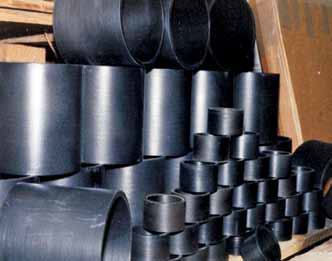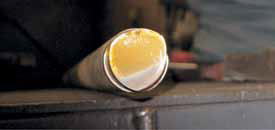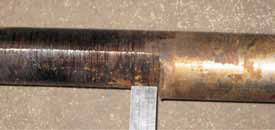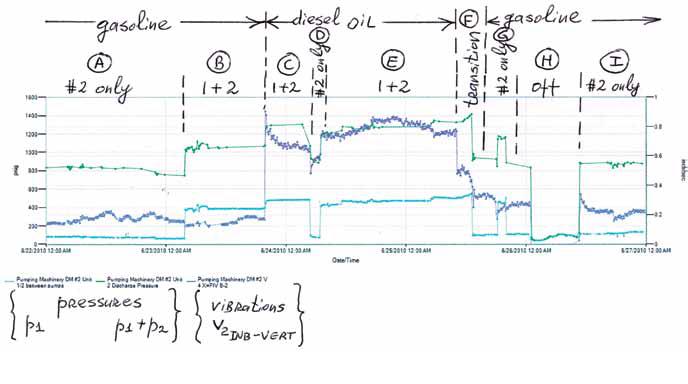Guide bearings are often blamed for unrelated pump problems.
Frequently, guide bearings are incorrectly blamed for a problem that has nothing to do with the bearings. Unless the bearings have a material defect (which would be unusual), guide bearings do not cause pump problems. Rather, guide bearing failures are the result of other problems that the pump is experiencing.
A common misconception is that guide bearings cause shafts or sleeves to wear prematurely or cause shafts to break. This is not true. Guide bearing failures on vertical and horizontal pumps, and their respective line shafts, are usually the result of improper shaft alignment or improper alignment of the flanges on the pump, the column piping, spiders or pump bowl assemblies.
 |
| Structural graphite composite guide bearings for flood gates |
Bearing failures can also be the result of improper alignment of the pump when mounted to the base plate foundation. Other causes of premature bearing failures are:
- Excessive shaft movement caused by cavitation
- High radial loading because of hydraulic unbalance
- Excessive radial movement as a result of a mechanical unbalance of the impeller or rotor
- Lack of bearing lubrication
- Contaminants in the lubrication
- Improper machining and/or alignment of the bearing housings or bores
Bearings fail prematurely for many reasons, but the bearing itself is almost never the reason.
Amusement Park Pump Failure
In a recent case, engineering pump consultants analyzed a problem of premature pump failures for several large, vertical turbine pumps operated at an amusement park.
The pumps had experienced premature failures in an area of the park that pumped water, straw and animal waste. The operators were convinced that they had guide bearing problems based on what local repair shops and maintenance engineers had reported. In reality, this explanation was far from the truth.
The problem was the strainers attached to the pump's suction bell. The strainers were undersized (too small in area and size) for the amount of debris in the water. The pump strainer would quickly become clogged, and the pump would start to cavitate.
 |
| A broken line shaft that resulted from high radial loading caused by a clogged strainer |
An excessive amount of debris built up in the pump pit compounded the problem. Because of the cavitation, the shaft experienced excessive movement, which allowed debris to lodge between the shaft and the bearing bores. The debris in the bearing bores acted like emery paper and quickly opened the bearing clearances by wearing the shaft and the inside diameter of the guide bearing. The pump failed in a short period of time, and in some cases, the shaft was worn to the point of breakage.
Not understanding the problem, the maintenance department at the amusement park believed that they need better guide bearings and began trying different guide bearing materials. In every case, the pumps failed prematurely. They even tried to remove the suction strainer, which caused the pump to fail much more quickly, in just two days!
 |
| A broken spider bearing caused by high radial loads. |
The solution to the problem was to change the suction strainer, increasing the size and area by three times and introducing a strainer with developing (graduated) hole sizes. New structural graphite composite impellers and casing rings were also installed with new graphite composite guide bearings. Composite impellers were chosen because they are lightweight and 100 percent machined, as opposed to being cast, or molded, which can be unbalanced.
When changing guide bearings, changing the impellers, rings and guide bearings as a set is critical to ensure proper hydraulic and mechanical balance. This will give the pump a much longer mean time between failures. A separate pump system for backwashing the strainer was also recommended to this client.
 |
| Excessive wear on one side of the line shaft caused by high radial loads. |
Repair of Vertical Turbine Pumps in a Power Generation Station
Another case involved guide bearings for vertical turbine pumps in a power generating station for fuel oil pumps. The pumps were constantly sent to the central maintenance repair shop for overhaul. After trying many different types of guide bearing materials (the original guide bearings were bronze), the head of the maintenance department asked a service provider to examine the problem.
Again, the guide bearings were not the issue. Misalignment caused the pumps to repeatedly fail. After many years of operation and overhaul repair, the bearing journals were not concentric with the column pipe flanges. This misalignment caused the guide bearings to wear quickly. Alignment is important, because if just one journal is not concentric the bearings will prematurely wear on one side, which causes early pump failure.
The diffuser bowl bearing journals, bowl flanges, spider bearing journals and flanges, and column pipe flanges were all re-machined to make sure that they were concentric. New structural graphite composite bearings were installed to ensure maximum pump life.
 |
| Structural graphite composite guide bearings after six years of operation. The long life was the combined result of using high quality composite bearings along with the re-machining of all flanges and journals to ensure concentricity. |
Pumps & Systems, November 2010

